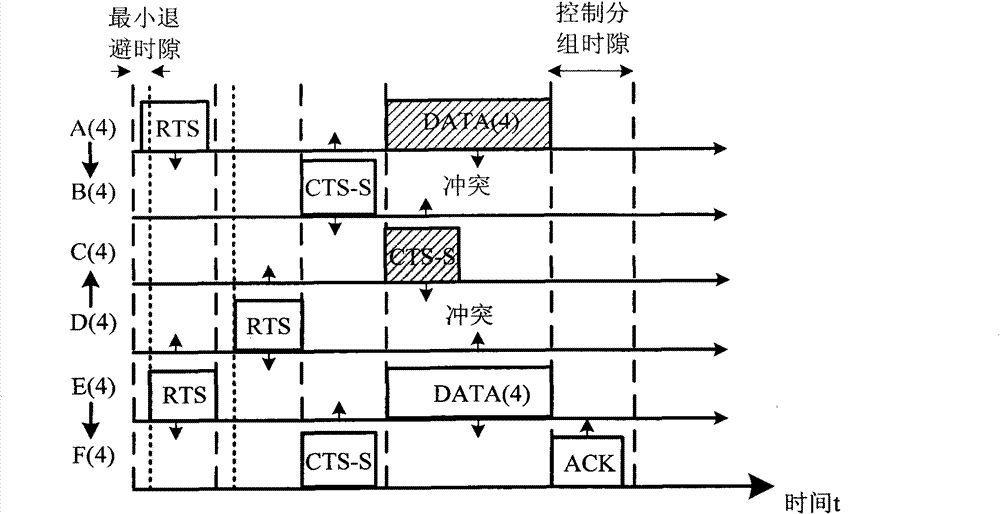Parallel RTS (remote terminal system) processing multiple access method supporting MIMO (multiple input multiple output) in ad hoc network
An access method and network technology, applied in the directions of network traffic/resource management, error prevention/detection using return channels, electrical components, etc. Throughput, avoid conflict, increase the effect of processing and calculation
- Summary
- Abstract
- Description
- Claims
- Application Information
AI Technical Summary
Problems solved by technology
Method used
Image
Examples
Embodiment 1
[0043] see figure 1 , the present invention is a parallel RTS processing multiple access method supporting MIMO in an ad hoc network, which retains the time structure of PRP-MAC, control grouping RTS grouping and ACK grouping, and defines a control grouping time slot as a basic time unit, each control packet is in the minimum backoff slot, which is also called the minimum backoff slot, and randomly accesses the channel on the basis of CSMA / CA. The control packet CTS of the present invention is also of two types, specifically the following two types: one is non-collision CTS-N, namely "CTS-Non collision", and the other is conflict-free CTS-C, namely "CTS-Collision" After the modification of the CTS grouping in the present invention, the carrier sense result can be effectively used to determine the maximum number of data streams that can be transmitted without conflict, and the number of data streams that can be simultaneously transmitted on the network exceeds 2 without calcula...
Embodiment 2
[0046] The parallel RTS processing multiple access method supporting MIMO in the ad hoc network is the same as that in Embodiment 1. All 1-hop adjacent nodes in the network are within the communication range and the 2-hop adjacent nodes are within the range of carrier sensing. Refer to Figure 4 . In the present invention, the CTS-N group is used in the following situation: a node only receives 1 or 2 RTS packets sent to the node, and there is no carrier sense to detect the RTS packets transmitted between other nodes, in this case Next, the CTS-N packet indicates to the sending node that all the number of antennas can be used for data transmission at this time; the CTS-C packet is used in the following situation: if a node not only receives the RTS packet whose destination node is itself, but also receives the RTS packet sent to RTS packets sent by other destination nodes, or only receive RTS packets whose destination node is itself but at the same time the carrier senses RTS ...
Embodiment 3
[0052] The parallel RTS processing multiple access method supporting MIMO in an ad hoc network is the same as that in Embodiment 2, see Figure 10 ,
[0053] The specific signal flow of the present invention is as follows:
[0054] (1) If the sending node U has business to send, it first senses the channel on the carrier, sends an RTS packet to the receiving node V for channel reservation, and waits for the feedback from the receiving node V;
[0055] (2) If the receiving node V only receives one or two RTS packets sent to this node, and at the same time, no carrier senses the RTS packets transmitted between other nodes, in this case, the receiving node V sends Node U replies with a CTS-N packet, indicating that the sending node U can use all the antennas for data transmission at this time;
[0056] (3) If the receiving node V not only receives the RTS packet whose destination node is itself, but also receives the RTS packet sent to other destination nodes, or only receives ...
PUM
 Login to View More
Login to View More Abstract
Description
Claims
Application Information
 Login to View More
Login to View More - R&D Engineer
- R&D Manager
- IP Professional
- Industry Leading Data Capabilities
- Powerful AI technology
- Patent DNA Extraction
Browse by: Latest US Patents, China's latest patents, Technical Efficacy Thesaurus, Application Domain, Technology Topic, Popular Technical Reports.
© 2024 PatSnap. All rights reserved.Legal|Privacy policy|Modern Slavery Act Transparency Statement|Sitemap|About US| Contact US: help@patsnap.com










